EBP Nursing: Fall Prevention Strategies and Implementation
VerifiedAdded on 2023/06/10
|5
|1282
|298
Essay
AI Summary
This essay explores the application of evidence-based practice (EBP) in nursing, specifically focusing on strategies for fall prevention among older adults. It appraises the evidence regarding the effectiveness of patient sitters in reducing fall rates and summarizes best practices for their utilization, including defining sitter qualifications, providing training programs, and establishing a sitter pool. The essay also suggests strategies for implementing these practices within healthcare settings, using the PARiHS framework and multidisciplinary approaches, while addressing potential barriers such as lack of knowledge among nurses and limited management support. The ultimate goal is to promote safer patient care through the integration of well-researched evidence into clinical practice. Desklib provides a platform to access similar well-researched assignments.
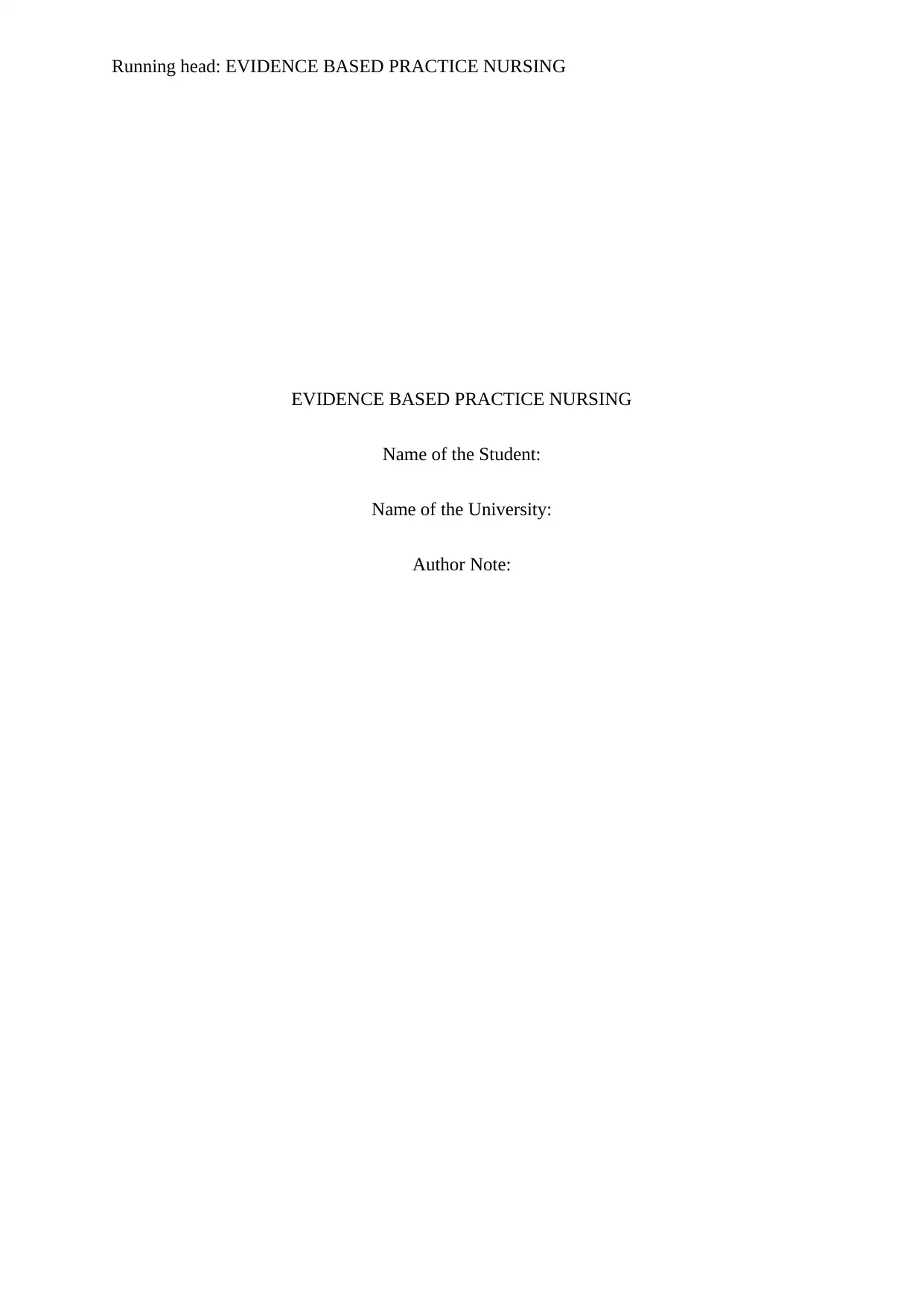
Running head: EVIDENCE BASED PRACTICE NURSING
EVIDENCE BASED PRACTICE NURSING
Name of the Student:
Name of the University:
Author Note:
EVIDENCE BASED PRACTICE NURSING
Name of the Student:
Name of the University:
Author Note:
Paraphrase This Document
Need a fresh take? Get an instant paraphrase of this document with our AI Paraphraser
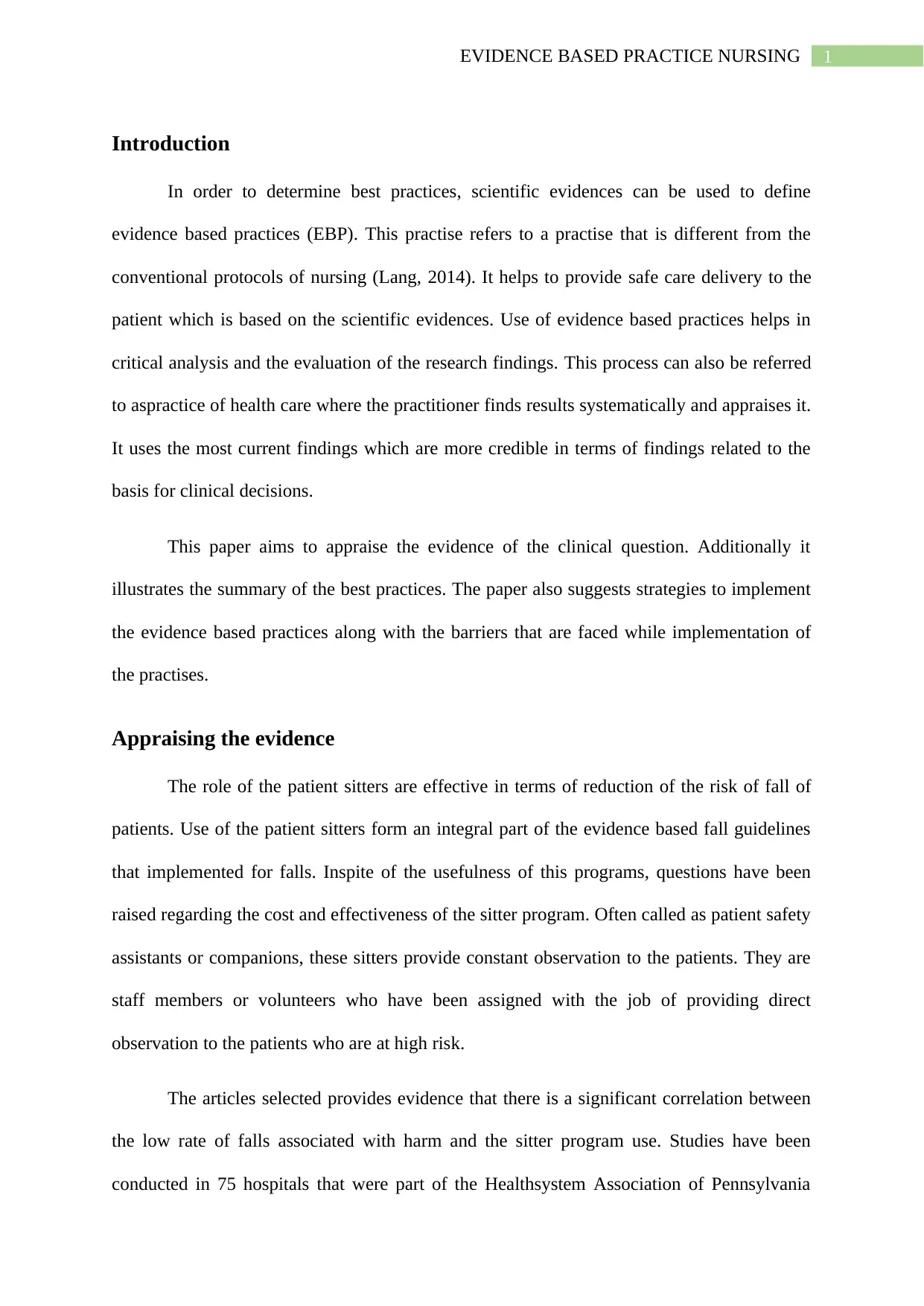
1EVIDENCE BASED PRACTICE NURSING
Introduction
In order to determine best practices, scientific evidences can be used to define
evidence based practices (EBP). This practise refers to a practise that is different from the
conventional protocols of nursing (Lang, 2014). It helps to provide safe care delivery to the
patient which is based on the scientific evidences. Use of evidence based practices helps in
critical analysis and the evaluation of the research findings. This process can also be referred
to aspractice of health care where the practitioner finds results systematically and appraises it.
It uses the most current findings which are more credible in terms of findings related to the
basis for clinical decisions.
This paper aims to appraise the evidence of the clinical question. Additionally it
illustrates the summary of the best practices. The paper also suggests strategies to implement
the evidence based practices along with the barriers that are faced while implementation of
the practises.
Appraising the evidence
The role of the patient sitters are effective in terms of reduction of the risk of fall of
patients. Use of the patient sitters form an integral part of the evidence based fall guidelines
that implemented for falls. Inspite of the usefulness of this programs, questions have been
raised regarding the cost and effectiveness of the sitter program. Often called as patient safety
assistants or companions, these sitters provide constant observation to the patients. They are
staff members or volunteers who have been assigned with the job of providing direct
observation to the patients who are at high risk.
The articles selected provides evidence that there is a significant correlation between
the low rate of falls associated with harm and the sitter program use. Studies have been
conducted in 75 hospitals that were part of the Healthsystem Association of Pennsylvania
Introduction
In order to determine best practices, scientific evidences can be used to define
evidence based practices (EBP). This practise refers to a practise that is different from the
conventional protocols of nursing (Lang, 2014). It helps to provide safe care delivery to the
patient which is based on the scientific evidences. Use of evidence based practices helps in
critical analysis and the evaluation of the research findings. This process can also be referred
to aspractice of health care where the practitioner finds results systematically and appraises it.
It uses the most current findings which are more credible in terms of findings related to the
basis for clinical decisions.
This paper aims to appraise the evidence of the clinical question. Additionally it
illustrates the summary of the best practices. The paper also suggests strategies to implement
the evidence based practices along with the barriers that are faced while implementation of
the practises.
Appraising the evidence
The role of the patient sitters are effective in terms of reduction of the risk of fall of
patients. Use of the patient sitters form an integral part of the evidence based fall guidelines
that implemented for falls. Inspite of the usefulness of this programs, questions have been
raised regarding the cost and effectiveness of the sitter program. Often called as patient safety
assistants or companions, these sitters provide constant observation to the patients. They are
staff members or volunteers who have been assigned with the job of providing direct
observation to the patients who are at high risk.
The articles selected provides evidence that there is a significant correlation between
the low rate of falls associated with harm and the sitter program use. Studies have been
conducted in 75 hospitals that were part of the Healthsystem Association of Pennsylvania
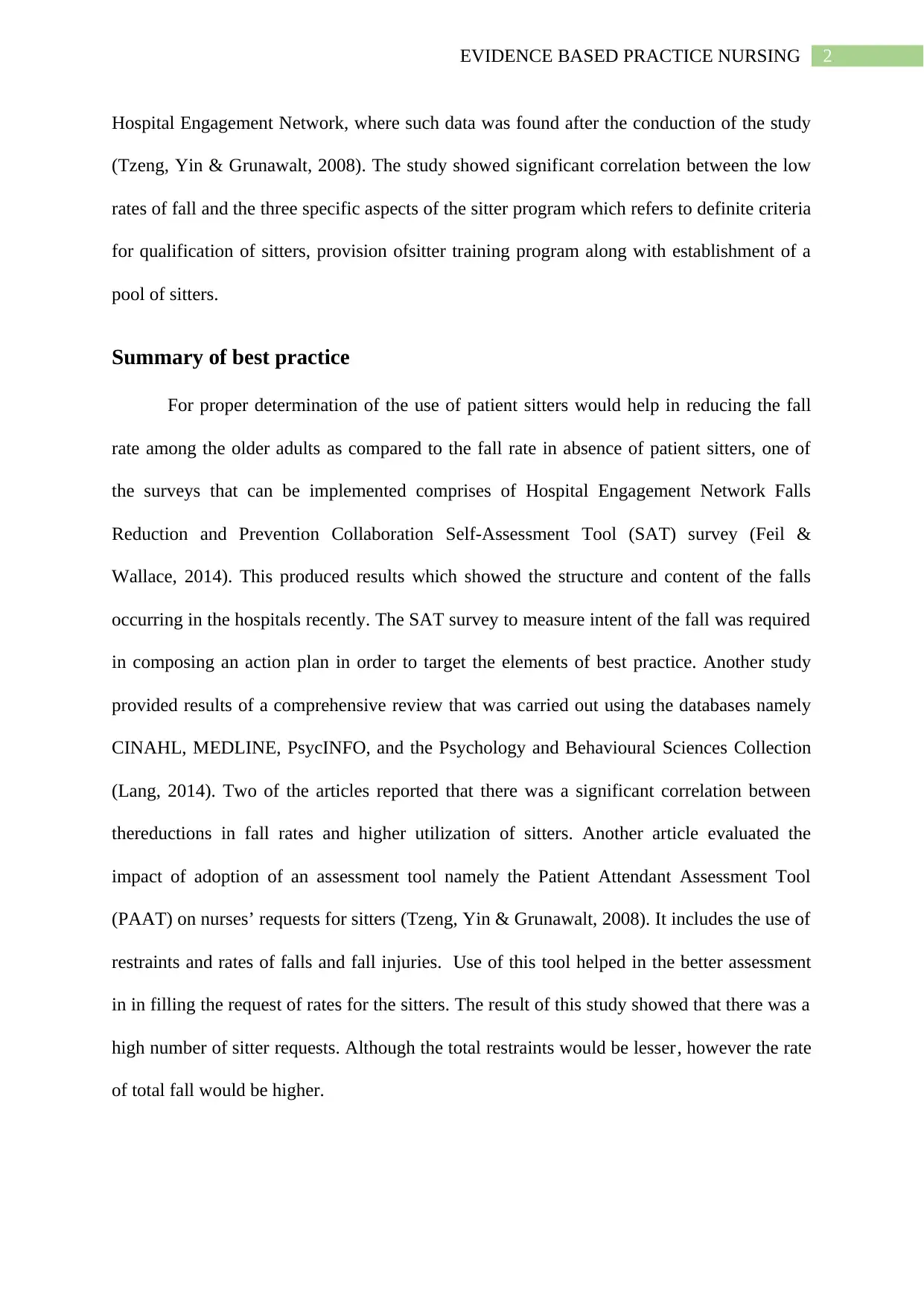
2EVIDENCE BASED PRACTICE NURSING
Hospital Engagement Network, where such data was found after the conduction of the study
(Tzeng, Yin & Grunawalt, 2008). The study showed significant correlation between the low
rates of fall and the three specific aspects of the sitter program which refers to definite criteria
for qualification of sitters, provision ofsitter training program along with establishment of a
pool of sitters.
Summary of best practice
For proper determination of the use of patient sitters would help in reducing the fall
rate among the older adults as compared to the fall rate in absence of patient sitters, one of
the surveys that can be implemented comprises of Hospital Engagement Network Falls
Reduction and Prevention Collaboration Self-Assessment Tool (SAT) survey (Feil &
Wallace, 2014). This produced results which showed the structure and content of the falls
occurring in the hospitals recently. The SAT survey to measure intent of the fall was required
in composing an action plan in order to target the elements of best practice. Another study
provided results of a comprehensive review that was carried out using the databases namely
CINAHL, MEDLINE, PsycINFO, and the Psychology and Behavioural Sciences Collection
(Lang, 2014). Two of the articles reported that there was a significant correlation between
thereductions in fall rates and higher utilization of sitters. Another article evaluated the
impact of adoption of an assessment tool namely the Patient Attendant Assessment Tool
(PAAT) on nurses’ requests for sitters (Tzeng, Yin & Grunawalt, 2008). It includes the use of
restraints and rates of falls and fall injuries. Use of this tool helped in the better assessment
in in filling the request of rates for the sitters. The result of this study showed that there was a
high number of sitter requests. Although the total restraints would be lesser, however the rate
of total fall would be higher.
Hospital Engagement Network, where such data was found after the conduction of the study
(Tzeng, Yin & Grunawalt, 2008). The study showed significant correlation between the low
rates of fall and the three specific aspects of the sitter program which refers to definite criteria
for qualification of sitters, provision ofsitter training program along with establishment of a
pool of sitters.
Summary of best practice
For proper determination of the use of patient sitters would help in reducing the fall
rate among the older adults as compared to the fall rate in absence of patient sitters, one of
the surveys that can be implemented comprises of Hospital Engagement Network Falls
Reduction and Prevention Collaboration Self-Assessment Tool (SAT) survey (Feil &
Wallace, 2014). This produced results which showed the structure and content of the falls
occurring in the hospitals recently. The SAT survey to measure intent of the fall was required
in composing an action plan in order to target the elements of best practice. Another study
provided results of a comprehensive review that was carried out using the databases namely
CINAHL, MEDLINE, PsycINFO, and the Psychology and Behavioural Sciences Collection
(Lang, 2014). Two of the articles reported that there was a significant correlation between
thereductions in fall rates and higher utilization of sitters. Another article evaluated the
impact of adoption of an assessment tool namely the Patient Attendant Assessment Tool
(PAAT) on nurses’ requests for sitters (Tzeng, Yin & Grunawalt, 2008). It includes the use of
restraints and rates of falls and fall injuries. Use of this tool helped in the better assessment
in in filling the request of rates for the sitters. The result of this study showed that there was a
high number of sitter requests. Although the total restraints would be lesser, however the rate
of total fall would be higher.
⊘ This is a preview!⊘
Do you want full access?
Subscribe today to unlock all pages.

Trusted by 1+ million students worldwide
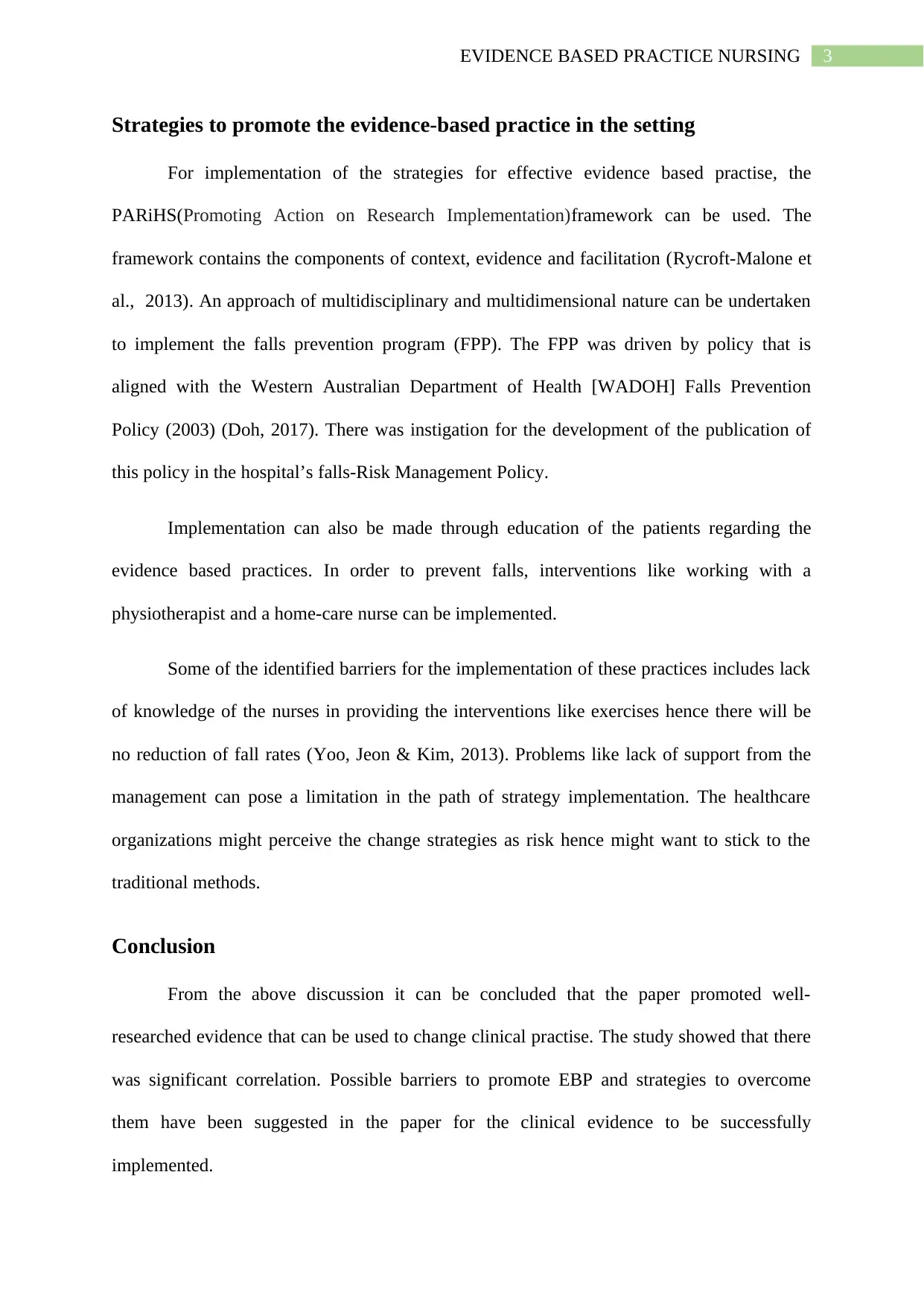
3EVIDENCE BASED PRACTICE NURSING
Strategies to promote the evidence-based practice in the setting
For implementation of the strategies for effective evidence based practise, the
PARiHS(Promoting Action on Research Implementation)framework can be used. The
framework contains the components of context, evidence and facilitation (Rycroft-Malone et
al., 2013). An approach of multidisciplinary and multidimensional nature can be undertaken
to implement the falls prevention program (FPP). The FPP was driven by policy that is
aligned with the Western Australian Department of Health [WADOH] Falls Prevention
Policy (2003) (Doh, 2017). There was instigation for the development of the publication of
this policy in the hospital’s falls-Risk Management Policy.
Implementation can also be made through education of the patients regarding the
evidence based practices. In order to prevent falls, interventions like working with a
physiotherapist and a home-care nurse can be implemented.
Some of the identified barriers for the implementation of these practices includes lack
of knowledge of the nurses in providing the interventions like exercises hence there will be
no reduction of fall rates (Yoo, Jeon & Kim, 2013). Problems like lack of support from the
management can pose a limitation in the path of strategy implementation. The healthcare
organizations might perceive the change strategies as risk hence might want to stick to the
traditional methods.
Conclusion
From the above discussion it can be concluded that the paper promoted well-
researched evidence that can be used to change clinical practise. The study showed that there
was significant correlation. Possible barriers to promote EBP and strategies to overcome
them have been suggested in the paper for the clinical evidence to be successfully
implemented.
Strategies to promote the evidence-based practice in the setting
For implementation of the strategies for effective evidence based practise, the
PARiHS(Promoting Action on Research Implementation)framework can be used. The
framework contains the components of context, evidence and facilitation (Rycroft-Malone et
al., 2013). An approach of multidisciplinary and multidimensional nature can be undertaken
to implement the falls prevention program (FPP). The FPP was driven by policy that is
aligned with the Western Australian Department of Health [WADOH] Falls Prevention
Policy (2003) (Doh, 2017). There was instigation for the development of the publication of
this policy in the hospital’s falls-Risk Management Policy.
Implementation can also be made through education of the patients regarding the
evidence based practices. In order to prevent falls, interventions like working with a
physiotherapist and a home-care nurse can be implemented.
Some of the identified barriers for the implementation of these practices includes lack
of knowledge of the nurses in providing the interventions like exercises hence there will be
no reduction of fall rates (Yoo, Jeon & Kim, 2013). Problems like lack of support from the
management can pose a limitation in the path of strategy implementation. The healthcare
organizations might perceive the change strategies as risk hence might want to stick to the
traditional methods.
Conclusion
From the above discussion it can be concluded that the paper promoted well-
researched evidence that can be used to change clinical practise. The study showed that there
was significant correlation. Possible barriers to promote EBP and strategies to overcome
them have been suggested in the paper for the clinical evidence to be successfully
implemented.
Paraphrase This Document
Need a fresh take? Get an instant paraphrase of this document with our AI Paraphraser
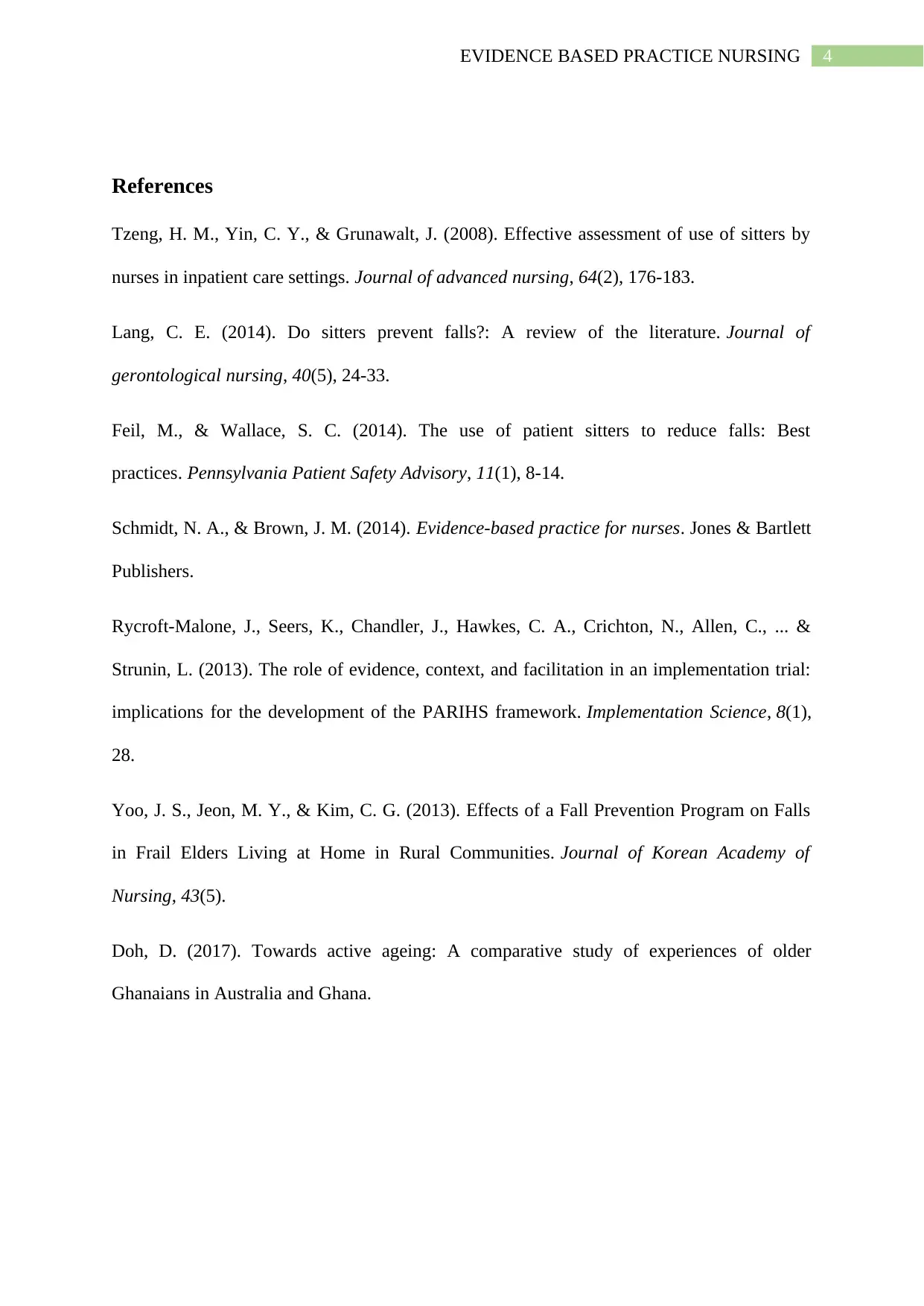
4EVIDENCE BASED PRACTICE NURSING
References
Tzeng, H. M., Yin, C. Y., & Grunawalt, J. (2008). Effective assessment of use of sitters by
nurses in inpatient care settings. Journal of advanced nursing, 64(2), 176-183.
Lang, C. E. (2014). Do sitters prevent falls?: A review of the literature. Journal of
gerontological nursing, 40(5), 24-33.
Feil, M., & Wallace, S. C. (2014). The use of patient sitters to reduce falls: Best
practices. Pennsylvania Patient Safety Advisory, 11(1), 8-14.
Schmidt, N. A., & Brown, J. M. (2014). Evidence-based practice for nurses. Jones & Bartlett
Publishers.
Rycroft-Malone, J., Seers, K., Chandler, J., Hawkes, C. A., Crichton, N., Allen, C., ... &
Strunin, L. (2013). The role of evidence, context, and facilitation in an implementation trial:
implications for the development of the PARIHS framework. Implementation Science, 8(1),
28.
Yoo, J. S., Jeon, M. Y., & Kim, C. G. (2013). Effects of a Fall Prevention Program on Falls
in Frail Elders Living at Home in Rural Communities. Journal of Korean Academy of
Nursing, 43(5).
Doh, D. (2017). Towards active ageing: A comparative study of experiences of older
Ghanaians in Australia and Ghana.
References
Tzeng, H. M., Yin, C. Y., & Grunawalt, J. (2008). Effective assessment of use of sitters by
nurses in inpatient care settings. Journal of advanced nursing, 64(2), 176-183.
Lang, C. E. (2014). Do sitters prevent falls?: A review of the literature. Journal of
gerontological nursing, 40(5), 24-33.
Feil, M., & Wallace, S. C. (2014). The use of patient sitters to reduce falls: Best
practices. Pennsylvania Patient Safety Advisory, 11(1), 8-14.
Schmidt, N. A., & Brown, J. M. (2014). Evidence-based practice for nurses. Jones & Bartlett
Publishers.
Rycroft-Malone, J., Seers, K., Chandler, J., Hawkes, C. A., Crichton, N., Allen, C., ... &
Strunin, L. (2013). The role of evidence, context, and facilitation in an implementation trial:
implications for the development of the PARIHS framework. Implementation Science, 8(1),
28.
Yoo, J. S., Jeon, M. Y., & Kim, C. G. (2013). Effects of a Fall Prevention Program on Falls
in Frail Elders Living at Home in Rural Communities. Journal of Korean Academy of
Nursing, 43(5).
Doh, D. (2017). Towards active ageing: A comparative study of experiences of older
Ghanaians in Australia and Ghana.
1 out of 5
Related Documents
Your All-in-One AI-Powered Toolkit for Academic Success.
+13062052269
info@desklib.com
Available 24*7 on WhatsApp / Email
![[object Object]](/_next/static/media/star-bottom.7253800d.svg)
Unlock your academic potential
Copyright © 2020–2025 A2Z Services. All Rights Reserved. Developed and managed by ZUCOL.




